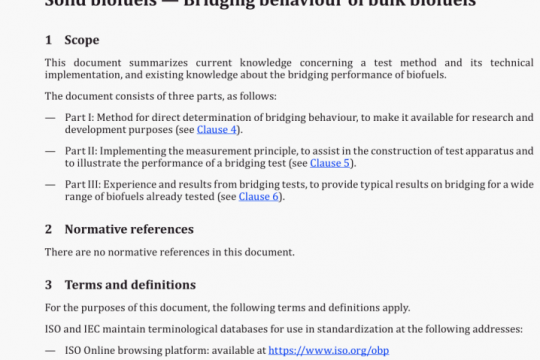ISO 8362-5 pdf free download
ISO 8362-5-2008 pdf free download.Injection containers and accessories一 Part 5: Freeze drying closures for injection vials.
4.8 The freeze drying closure shall be designed and manufactured in such a way that the removal of the reconstituted product with a hypodermic needle can be visually controlled in order to minimize the amount of residual product.
4.9 When freeze drying closures are put in place for the lyophilization process and the container is exposed to transportation processes, they should exhibit sufficient shock and vibration resistance that, under regular processing conditions, they do not fall off or become distorted.
5 Designation
A freeze drying closure for injection vials can be designated by the words freeze drying closure” followed by the number of this part of ISO 8362 followed by the nominal size.
EXAMPLE A freeze drying closure of nominal size 13 complying with the requirements laid down in this part of ISO 8362 is designated as follows:
Freeze drying closure ISO 8362-5 — 13
6 Material
The elastomeric material used shall meet the requirements specified in Clause 7.
The elastomeric material shall withstand two sterilization cycles when autoclaving in saturated steam at (121 ± 2) °C for 30 mm without exceeding the specified limits and without impairment of its performance characteristics under conditions of normal use. In case other sterilization methods are used, e.g. irradiation. the suitability of the material shall be evaluated.
With regard to the special requirement for low residual moisture, the drying process shall be included in the evaluation of the material’s performance characteristics (see also 7.2.7).
Closures shall be made from the elastomeric formulation originally tested and approved by the end user. The closure manufacturer shall ensure the conformance of each delivery with the type sample and the compliance with previously agreed functional and compendial requirements.
NOTE It is current practice to prefer elastomeric materials that use straight or halogenated butyl rubbers as a base polymer, since this class of materials exhibits an excellent barrier function against water vapour and gas permeation.
7 Performance requirements
7.1 General
The requirements specified in 7.2 to 7.4 represent minimum requirements which refer to the condition of the
elastomenc closures on receipt by the user.
7.2 Physical requirements
7.2.1 Hardness
The hardness agreed between manufacturer and user shall not differ from the nominal value by more than ± 5 Shore A when tested in accordance with ISO 7619-1 on a special test specimen. Alternatively, the hardness can be tested on the closures in accordance with ISO 48. If tested in accordance with ISO 48, the microhardness shall not differ by more than ± 5 IRHO from the type sample.
7.2.2 PenetrabIlity
The requirements of ISO 887 1-5:2005, 4.1, shall apply.
7.2.3 Fragmentation
The requirements of ISO 8871-5:2005, 4.2, shall apply.
7.2.4 Self-sealing and container closure seal integrity
The requirements of ISO 8871-5:2005, 4.3, shall apply.
7.2.5 ContaIner closure seal Integrity
The requirements of ISO 8871-5:2005, 4.4, shall apply. If the test specimen complies with 7.2.4, the requirements of this subclause have also been met and separate testing according to this subclause is not needed.
7.2.6 Resistance to ageing
The maximum time between the date of manufacture and the pharmaceutical use should be agreed upon between the manufacturer of the closures and the user.
The closures shall maintain their performance characteristics throughout the entire shelf-life of the medicinal product, which is tested as part of the stability test by the user.
NOTE Ageing depends upon the storage and handling conditions. Guidelines for storage of vulcanized rubber is given in ISO 2230.
7.2.7 Residual moisture
Upon request, the rubber manufacturer shall give a recommendation as to the time and temperature (time/temperature profile) at which the user can reduce residual moisture from freeze drying closures to end up with a pie-defined moisture level, as exposure to dry heat may damage the elastomeric material.
Residual moisture can be determined in accordance with Annex A.
7.3 Chemical requirements
The requirements in ISO 8871-1 shall apply.
7.4 Biological requirements
The requirements in ISO 8871-4 shall apply.
8 Labelling
Packed closures that meet the requirements of this part of ISO 8362 can be labelled with the designation given in Clause 5.ISO 8362-5 pdf download.




